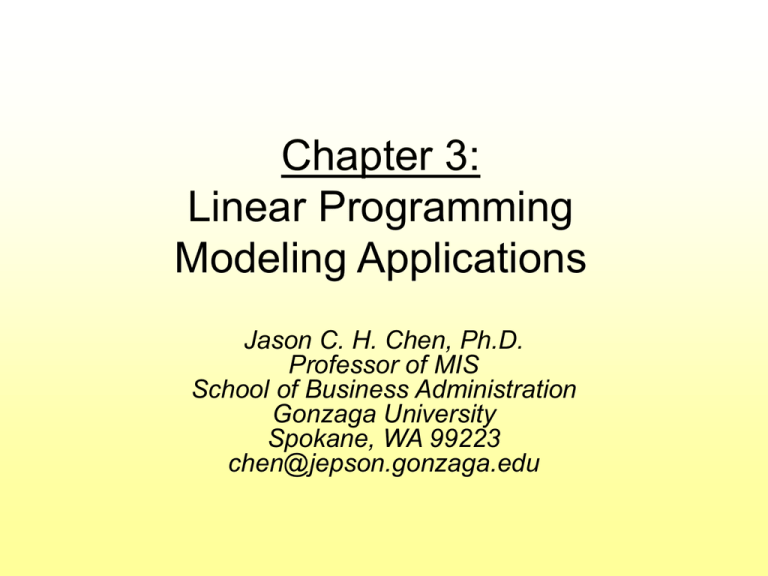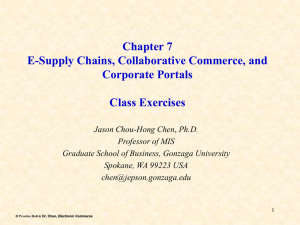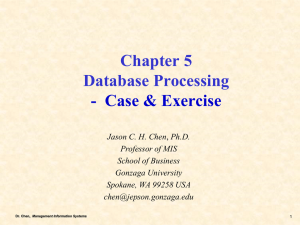Chapter 3: Linear Programming Modeling Applications
advertisement

Chapter 3: Linear Programming Modeling Applications Jason C. H. Chen, Ph.D. Professor of MIS School of Business Administration Gonzaga University Spokane, WA 99223 chen@jepson.gonzaga.edu Linear Programming (LP) Can Be Used for Many Managerial Decisions: • 1. Manufacturing applications – Product mix – Make-buy • 2. Marketing applications – Media selection – Marketing research • 3. Finance application – Portfolio selection • 4. Transportation application and others – Shipping & transportation – Multiperiod scheduling Dr. Chen, Decision Support Systems 2 For a particular application we begin with the problem scenario and data, then: 1) Define the decision variables 2) Formulate the LP model using the decision variables • • Write the objective function equation Write each of the constraint equations 3) Implement the model in Excel 4) Solve with Excel’s Solver Dr. Chen, Decision Support Systems 3 Manufacturing Applications Product Mix Problem: Fifth Avenue Industries • Produce 4 types of men's ties • Use 3 materials (limited resources) Decision: How many of each type of tie to make per month? Objective: Maximize profit Dr. Chen, Decision Support Systems 4 Resource Data Material Silk Yards available Cost per yard per month $20 1,000 Polyester $6 2,000 Cotton $9 1,250 Labor cost is $0.75 per tie Dr. Chen, Decision Support Systems 5 Product Data Type of Tie Silk Selling Price (per tie) Monthly Minimum Monthly Maximum Total material (yards per tie) Dr. Chen, Decision Support Systems Polyester Blend 1 Blend 2 $6.70 $3.55 $4.31 $4.81 6,000 10,000 13,000 6,000 7,000 14,000 16,000 8,500 0.125 0.08 0.10 0.10 6 Material Requirements (yards per tie) Type of Tie Material Silk Blend 1 Polyester (50/50) Blend 2 (30/70) Silk 0.125 0 0 0 Polyester 0 0.08 0.05 0.03 Cotton 0 0 0.05 0.07 0.125 0.08 0.10 0.10 Total yards Dr. Chen, Decision Support Systems 7 Decision Variables S = number of silk ties to make per month P = number of polyester ties to make per month B1 = number of poly-cotton blend 1 ties to make per month B2 = number of poly-cotton blend 2 ties to make per month Dr. Chen, Decision Support Systems 8 Profit Per Tie Calculation Profit per tie = (Selling price) – (material cost) –(labor cost) Silk Tie Profit = $6.70 – (0.125 yds)($20/yd) - $0.75 = $3.45 per tie Dr. Chen, Decision Support Systems 9 Objective Function (in $ of profit) Max 3.45S + 2.32P + 2.81B1 + 3.25B2 Subject to the constraints: Material Limitations (in yards) 0.125S < 1,000 (silk) 0.08P + 0.05B1 + 0.03B2 < 2,000 (poly) 0.05B1 + 0.07B2 Dr. Chen, Decision Support Systems < 1,250 (cotton) 10 Min and Max Number of Ties to Make 6,000 < S < 7,000 10,000 < P < 14,000 13,000 < B1 < 16,000 6,000 < B2 < 8,500 Finally nonnegativity S, P, B1, B2 > 0 Dr. Chen, Decision Support Systems 11 LP Model for Product Mix Problem Max 3.45S + 2.32P + 2.81B1 + 3.25B2 Subject to the constraints: 0.125S < 1,000 (yards of silk) 0.08P + 0.05B1 + 0.03B2 < 2,000 (yards of poly) 0.05B1 + 0.07B2 < 1,250 (yards of cotton) 6,000 < S < 7,000 10,000 < P < 14,000 13,000 < B1 < 16,000 6,000 < B2 < 8,500 S, P, B1, B2 > 0 Go to file 3-1.xls Dr. Chen, Decision Support Systems 12 Fifth Avenue Industries S P B1 B2 All silk All poly Blend-1 Blend2 Number of units 7000.0 13625.0 13100.0 8500.0 Selling price $6.70 $3.55 $4.31 $4.81 $192,614.75 Labor cost $0.75 $0.75 $0.75 $0.75 $31,668.75 Material cost $2.50 $0.48 $0.75 $0.81 $40,750.00 Profit $3.45 $2.32 $2.81 $3.25 $120,196.00 Constraints: Yards of silk Cost/Yd 0.125 Yards of polyester 0.08 Yards of cotton Maximum all silk Minimum all poly Minimum blend-1 <= 2000 $6 0.05 0.07 1250.00 <= 1250 $9 7000.00 <= 7000 13625.00 <= 14000 13100.00 <= 16000 8500.00 <= 8500 7000.00 >= 6000 13625.00 >= 10000 13100.00 >= 13000 8500.00 >= 6000 1 1 1 1 1 Minimum blend-2 Dr. Chen, Decision Support Systems $20 2000.00 Maximum blend-2 Minimum all silk 1000 0.03 1 Maximum blend-1 <= 0.05 1 Maximum all poly 875.00 1 Go to file 3-1.xls LHS Sign RHS 13 Marketing applications Media Selection Problem: Win Big Gambling Club • Promote gambling trips to the Bahamas • Budget: $8,000 per week for advertising • Use 4 types of advertising Decision: How many ads of each type? Objective: Maximize audience reached Dr. Chen, Decision Support Systems 14 Data TV Spot Advertising Options Radio Newspaper (prime time) Radio (afternoon) Audience Reached (per ad) 5,000 8,500 2,400 2,800 Cost (per ad) $800 $925 $290 $380 Max Ads Per week 12 5 25 20 Dr. Chen, Decision Support Systems 15 Other Restrictions • Have at least 5 radio spots per week • Spend no more than $1800 on radio Decision Variables T = number of TV spots per week N = number of newspaper ads per week P = number of prime time radio spots per week A = number of afternoon radio spots per week Dr. Chen, Decision Support Systems 16 Objective Function (in num. audience reached) Max 5000T + 8500N + 2400P + 2800A Subject to the constraints: Budget is $8000 800T + 925N + 290P + 380A < 8000 At Least 5 Radio Spots per Week P+A>5 Dr. Chen, Decision Support Systems 17 No More Than $1800 per Week for Radio 290P + 380A < 1800 Max Number of Ads per Week T < 12 N< 5 Finally nonnegativity Dr. Chen, Decision Support Systems P < 25 A < 20 T, N, P, A > 0 18 LP Model for Media Selection Problem Objective Function Max 5000T + 8500N + 2400P + 2800A Subject to the constraints: 800T + 925N + 290P + 380A < 8000 P+A >5 290P + 380A < 1800 T < 12 P < 25 N < 5 A < 20 T, N, P, A > 0 Go to file 3-3.xls Dr. Chen, Decision Support Systems 19 Win Big Gambling Club T N P A TV spots Newspap er ads Primetime radio spots Afternoon radio spots Number of units 1.97 5.00 6.21 0.00 Audience 5000 8500 2400 2800 67240.30 Constraints: Maximum TV 1 Maximum newspaper 1 Max prime-time radio 1 Max afternoon radio Total budget Maximum radio $ Minimum radio spots 1 $800 $925 1.97 <= 12 5.00 <= 5 6.21 <= 25 0.00 <= 20 $290 $380 $8,000.00 <= $8,000 $290 $380 $1,800.00 <= $1,800 1 1 6.21 >= 5 LHS Sign RHS Go to file 3-3.xls Dr. Chen, Decision Support Systems 20 Finance application Portfolio Selection: International City Trust Has $5 million to invest among 6 investments Decision: How much to invest in each of 6 investment options? Objective: Maximize interest earned Dr. Chen, Decision Support Systems 21 Data Interest Rate Risk Score Trade credits 7% 1.7 Corp. bonds 10% 1.2 Gold stocks 19% 3.7 Platinum stocks 12% 2.4 Mortgage securities 8% 2.0 Construction loans 14% 2.9 Investment Dr. Chen, Decision Support Systems 22 Constraints • Invest up to $ 5 million • No more than 25% into any one investment • At least 30% into precious metals • At least 45% into trade credits and corporate bonds • Limit overall risk to no more than 2.0 Dr. Chen, Decision Support Systems 23 Decision Variables T = $ invested in trade credit B = $ invested in corporate bonds G = $ invested gold stocks P = $ invested in platinum stocks M = $ invested in mortgage securities C = $ invested in construction loans Dr. Chen, Decision Support Systems 24 Objective Function (in $ of interest earned) Max 0.07T + 0.10B + 0.19G + 0.12P + 0.08M + 0.14C Subject to the constraints: Invest Up To $5 Million T + B + G + P + M + C < 5,000,000 Dr. Chen, Decision Support Systems 25 No More Than 25% Into Any One Investment T < 0.25 (T + B + G + P + M + C) B < 0.25 (T + B + G + P + M + C) G < 0.25 (T + B + G + P + M + C) P < 0.25 (T + B + G + P + M + C) M < 0.25 (T + B + G + P + M + C) C < 0.25 (T + B + G + P + M + C) Dr. Chen, Decision Support Systems 26 At Least 30% Into Precious Metals G + P > 0.30 (T + B + G + P + M + C) At Least 45% Into Trade Credits And Corporate Bonds T + B > 0.45 (T + B + G + P + M + C) Dr. Chen, Decision Support Systems 27 Limit Overall Risk To No More Than 2.0 Use a weighted average to calculate portfolio risk 1.7T + 1.2B + 3.7G + 2.4P + 2.0M + 2.9C < 2.0 T+B+G+P+M+C OR 1.7T + 1.2B + 3.7G + 2.4P + 2.0M + 2.9C < 2.0 (T + B + G + P + M + C) finally nonnegativity: T, B, G, P, M, C > 0 Dr. Chen, Decision Support Systems 28 LP Model for Portfolio Selection Max 0.07T + 0.10B + 0.19G + 0.12P+ 0.08M + 0.14C Subject to the constraints: T + B + G + P + M + C < 5,000,000 (total funds) T < 0.25 (T + B + G + P + M + C) (Max trade credits) B < 0.25 (T + B + G + P + M + C) (Max corp bonds) G < 0.25 (T + B + G + P + M + C) (Max gold) P < 0.25 (T + B + G + P + M + C) (Max platinum) M < 0.25 (T + B + G + P + M + C) (Max mortgages) C < 0.25 (T + B + G + P + M + C) (Max const loans) 1.7T + 1.2B + 3.7G + 2.4P + 2.0M + 2.9C < 2.0 (T + B + G + P + M + C) (Risk score) G + P > 0.30 (T + B + G + P + M + C) (precious metal) T + B > 0.45 (T + B + G + P + M + C) (Trade credits & bonds) T, B, G, P, M, C > 0 Dr. Chen, Decision Support Systems Go to file 3-5.xls 29 International City Trust T B G P M C Trade credits Corp bonds Gold Platinum Mortgages Const loans $1,250,000.00 $1,250,000.00 $250,000.00 $1,250,000.00 $500,000.00 $500,000.00 0.07 0.10 0.19 0.12 0.08 0.14 Total funds 1 1 1 1 1 1 Max trade credits 1 Dollars Invested Interest $520,000.00 Constraints: Max corp bonds 1 Max gold 1 Max mortgages $5,000,000 $1,250,000.00 <= $1,250,000 $1,250,000.00 <= $1,250,000 $250,000.00 <= $1,250,000 $1,250,000.00 <= $1,250,000 $500,000.00 <= $1,250,000 $500,000.00 <= $1,250,000 10,000,000.00 <= 10,000,000 $1,500,000.00 >= $1,500,000 $2,500,000.00 >= $2,250,000 LHS Sign RHS 1 Max const loans 1 1.7 1.2 Precious metals Trade credits & bonds <= 1 Max platinum Risk score $5,000,000.00 1 Dr. Chen, Decision Support Systems 1 3.7 2.4 1 1 2.0 2.9 Go to file 3-5.xls 30 Employee Staffing Application Labor Planning: Hong Kong Bank Number of tellers needed varies by time of day Decision: How many tellers should begin work at various times of the day? Objective: Minimize personnel cost Dr. Chen, Decision Support Systems 31 Time Period 9 – 10 10 – 11 11 – 12 Min Num. Tellers 10 12 14 12 – 1 1–2 2-3 3–4 4–5 16 18 17 15 10 Total minimum daily requirement is 112 hours Dr. Chen, Decision Support Systems 32 Full Time Tellers • Work from 9 AM – 5 PM • Take a 1 hour lunch break, half at 11, the other half at noon • Cost $90 per day (salary & benefits) • Currently only 12 are available Dr. Chen, Decision Support Systems 33 Part Time Tellers • Work 4 consecutive hours (no lunch break) • Can begin work at 9, 10, 11, noon, or 1 • Are paid $7 per hour ($28 per day) • Part time teller hours cannot exceed 50% of the day’s minimum requirement (50% of 112 hours = 56 hours) Dr. Chen, Decision Support Systems 34 Decision Variables F = num. of full time tellers (all work 9–5) P1 = num. of part time tellers who work 9–1 P2 = num. of part time tellers who work 10–2 P3 = num. of part time tellers who work 11–3 P4 = num. of part time tellers who work 12–4 P5 = num. of part time tellers who work 1–5 Dr. Chen, Decision Support Systems 35 Objective Function (in $ of personnel cost) Min 90 F + 28 (P1 + P2 + P3 + P4 + P5) Subject to the constraints: Part Time Hours Cannot Exceed 56 Hours 4 (P1 + P2 + P3 + P4 + P5) < 56 Dr. Chen, Decision Support Systems 36 Minimum Num. Tellers Needed By Hour Time of Day F + P1 F + P1 + P2 0.5 F + P1 + P2 + P3 0.5 F + P1 + P2 + P3+ P4 F + P2 + P3+ P4 + P5 F + P3+ P4 + P5 F + P4 + P5 F + P5 Dr. Chen, Decision Support Systems > 10 > 12 > 14 > 16 > 18 > 17 > 15 > 10 (9-10) (10-11) (11-12) (12-1) (1-2) (2-3) (3-4) (4-5) 37 Only 12 Full Time Tellers Available F < 12 finally nonnegativity: F, P1, P2, P3, P4, P5 > 0 Dr. Chen, Decision Support Systems 38 LP Model for Labor Planning Min 90 F + 28 (P1 + P2 + P3 + P4 + P5) Subject to the constraints: F + P1 F + P1 + P2 0.5 F + P1 + P2 + P3 0.5 F + P1 + P2 + P3+ P4 F + P2 + P3+ P4 + P5 F + P3+ P4 + P5 F + P4 + P5 F + P5 F 4 (P1 + P2 + P3 + P4 + P5) F, P1, P2, P3, P4, P5 > 0 Dr. Chen, Decision Support Systems > 10 > 12 > 14 > 16 > 18 > 17 > 15 > 10 < 12 < 56 (9-10) (10-11) (11-12) (12-1) (1-2) (2-3) (3-4) (4-5) Go to file 3-6.xls 39 Hong Kong Bank F P1 P2 P3 P4 P5 FT tellers PT @9am PT @10am PT @11am PT @Noon PT @1pm 10.0 0.0 7.0 2.0 5.0 0.0 $90.00 $28.00 $28.00 $28.00 $28.00 $28.00 9am-10am needs 1 1 10am-11am needs 1 1 1 11am-Noon needs 0.5 1 1 1 Noon-1pm needs 0.5 1 1 1 1 1pm-2pm needs 1 1 1 1 2pm-3pm needs 1 1 3pm-4pm needs 1 4pm-5pm needs 1 Max full time 1 Number of tellers Cost $1,292.00 Constraints: Part-time limit 4 4 4 10.0 >= 10 17.0 >= 12 14.0 >= 14 19.0 >= 16 1 24.0 >= 18 1 1 17.0 >= 17 1 1 15.0 >= 15 1 10.0 >= 10 10.0 <= 12 56.0 <= 56 4 4 LHS Sign RHS Go to file 3-6.xls Dr. Chen, Decision Support Systems 40 Transportation application and others Vehicle Loading: Goodman Shipping How to load a truck subject to weight and volume limitations Decision: How much of each of 6 items to load onto a truck? Objective: Maximize the value shipped Dr. Chen, Decision Support Systems 41 Data Item 1 2 3 4 5 6 Value $15,500 $14,400 $10,350 $14,525 $13,000 $9,625 Pounds 5000 4500 3000 3500 4000 3500 $ / lb $3.10 $3.20 $3.45 $4.15 $3.25 $2.75 Cu. ft. per lb 0.125 0.064 0.144 0.448 0.048 0.018 Dr. Chen, Decision Support Systems 42 Decision Variables Wi = number of pounds of item i to load onto truck, (where i = 1,…,6) Truck Capacity • 15,000 pounds • 1,300 cubic feet Dr. Chen, Decision Support Systems 43 Objective Function (in $ of load value) Max 3.10W1 + 3.20W2 + 3.45W3 + 4.15W4 + 3.25W5 + 2.75W6 Subject to the constraints: Weight Limit Of 15,000 Pounds W1 + W2 + W3 + W4 + W5 + W6 < 15,000 Dr. Chen, Decision Support Systems 44 Volume Limit Of 1300 Cubic Feet 0.125W1 + 0.064W2 + 0.144W3 + 0.448W4 + 0.048W5 + 0.018W6 < 1300 Pounds of Each Item Available W1 < 5000 W4 < 3500 W2 < 4500 W5 < 4000 W3 < 3000 W6 < 3500 Finally nonnegativity: Wi > 0, i=1,…,6 Dr. Chen, Decision Support Systems 45 LP Model for Vehicle Loading Objective Function Max 3.10W1 +3.20W2 +3.45W3 +4.15W4 +3.25W5+2.75W6 Subject to the constraints: W1 + W 2 + W3 + W4 + W 5 + W6 0.125W1 + 0.064W2 + 0.144W3 +0.448W4 + 0.048W5 + 0.018W6 Pounds of Each Item Available W1 W2 W3 W4 W5 W6 Wi > 0, i=1,…,6 Dr. Chen, Decision Support Systems < 15,000 (Weight Limit) < 1300 (volume limit of truck) < 5000 (item 1 availability) < 4500 (item 2 availability) < 3000 (item 3 availability) < 3500 (item 4 availability) < 4000 (item 5 availability) < 3500 (item 6 availability) Go to file 3-7.xls 46 Goodman Shipping W1 W2 W3 W4 W5 W6 Item 1 Item 2 Item 3 Item 4 Item 5 Item 6 3,037.38 4,500.00 3,000.00 0.00 4,000.00 462.62 $3.10 $3.20 $3.45 $4.15 $3.25 $2.75 Weight limit 1 1 1 1 1 1 15000.00 <= 15000 Volume limit 0.125 0.064 0.144 0.448 0.048 0.018 1300.00 <= 1300 3037.38 <= 5000 4500.00 <= 4500 3000.00 <= 3000 0.00 <= 3500 4000.00 <= 4000 462.62 <= 3500 Weight in pounds Load value $48,438.08 Constraints: Item 1 limit (pounds) Item 2 limit (pounds) Item 3 limit (pounds) Item 4 limit (pounds) Item 5 limit (pounds) 1 1 1 1 1 Item 6 limit (pounds) 1 LHS Sign RHS Go to file 3-7.xls Dr. Chen, Decision Support Systems 47 Blending Problem: Whole Food Nutrition Center Making a natural cereal that satisfies minimum daily nutritional requirements Decision: How much of each of 3 grains to include in the cereal? Objective: Minimize cost of a 2 ounce serving of cereal Dr. Chen, Decision Support Systems 48 $ per pound Protein per pound Riboflavin per pound Phosphorus per pound Magnesium per pound Dr. Chen, Decision Support Systems A Grain B C 22 28 21 3 16 14 25 2 8 7 9 1 5 0 6 0.425 Minimum Daily $0.33 $0.47 $0.38 Requirement 49 Decision Variables A = pounds of grain A to use B = pounds of grain B to use C = pounds of grain C to use Note: grains will be blended to form a 2 ounce serving of cereal Dr. Chen, Decision Support Systems 50 Objective Function (in $ of cost) Min 0.33A + 0.47B + 0.38C Subject to the constraints: Total Blend is 2 Ounces, or 0.125 Pounds A + B + C = 0.125 Dr. Chen, Decision Support Systems (lbs) 51 Minimum Nutritional Requirements 22A + 28B + 21C > 3 (protein) 16A + 14B + 25C > 2 (riboflavin) 8A + 7B + 9C > 1 (phosphorus) 5A + 6C > 0.425 (magnesium) Finally nonnegativity: A, B, C > 0 Dr. Chen, Decision Support Systems 52 LP Model for a Blending Problem Objective Function Min 0.33A + 0.47B + 0.38C Subject to the constraints: 22A + 28B + 21C >3 (protein units) 16A + 14B + 25C >2 (riboflavin units) 8A + 7B + 9C >1 (phosphorus units) 5A + 6C > 0.425 (magnesium units) A+B+C = 0.125 (lbs of total mix) A, B, C > 0 Go to file 3-9.xls Dr. Chen, Decision Support Systems 53 Whole Food Nutrition Center A B C Grain A Grain B Grain C Number of pounds 0.025 0.050 0.050 Cost $0.33 $0.47 $0.38 $0.05 Protein 22 28 21 3.00 >= 3 Riboflavin 16 14 25 2.35 >= 2 Phosphorus 8 7 9 1.00 >= 1 Magnesium 5 6 0.425 >= 0.425 Total Mix 1 1 0.125 = 0.125 LHS Sign RHS Constraints: 1 file 3-9.xls Dr. Chen, Decision Support Systems 54 Multiperiod Scheduling: Greenberg Motors Need to schedule production of 2 electrical motors for each of the next 4 months Decision: How many of each type of motor to make each month? Objective: Minimize total production and inventory cost Dr. Chen, Decision Support Systems 55 Decision Variables PAt = number of motor A to produce in month t (t=1,…,4) PBt = number of motor B to produce in month t (t=1,…,4) IAt = inventory of motor A at end of month t (t=1,…,4) IBt = inventory of motor B at end of month t (t=1,…,4) Dr. Chen, Decision Support Systems 56 Sales Demand Data Motor A B Month 1 (January) 800 1000 2 (February) 700 1200 3 (March) 1000 1400 4 (April) 1100 Dr. Chen, Decision Support Systems 1400 57 Production Data Motor (values are per motor) A B Production cost $10 $6 Labor hours 1.3 0.9 • Production costs will be 10% higher in months 3 and 4 • Monthly labor hours most be between 2240 and 2560 Dr. Chen, Decision Support Systems 58 Inventory Data Motor A B Inventory cost $0.18 $0.13 (per motor per month) Beginning inventory 0 0 (beginning of month 1) Ending Inventory 450 300 (end of month 4) Max inventory is 3300 motors Dr. Chen, Decision Support Systems 59 Production and Inventory Balance (inventory at end of previous period) + (production the period) - (sales this period) = (inventory at end of this period) Dr. Chen, Decision Support Systems 60 Objective Function (in $ of cost) Min 10PA1 + 10PA2 + 11PA3 + 11PA4 + 6PB1 + 6 PB2 + 6.6PB3 + 6.6PB4 + 0.18(IA1 + IA2 + IA3 + IA4) + 0.13(IB1 + IB2 + IB3 + IB4) Subject to the constraints: (see next slide) Dr. Chen, Decision Support Systems 61 Production & Inventory Balance 0 + PA1 – 800 = IA1 (month 1) 0 + PB1 – 1000 = IB1 IA1 + PA2 – 700 = IA2 (month 2) IB1 + PB2 – 1200 = IB2 IA2 + PA3 – 1000 = IA3 (month 3) IB2 + PB3 – 1400 = IB3 IA3 + PA4 – 1100 = IA4 (month 4) IB3 + PB4 – 1400 = IB4 Dr. Chen, Decision Support Systems 62 Ending Inventory IA4 = 450 IB4 = 300 Maximum Inventory level IA1 + IB1 < 3300 (month 1) IA2 + IB2 < 3300 (month 2) IA3 + IB3 < 3300 (month 3) IA4 + IB4 < 3300 (month 4) Dr. Chen, Decision Support Systems 63 Range of Labor Hours 2240 < 1.3PA1 + 0.9PB1 < 2560 (month 1) 2240 < 1.3PA2 + 0.9PB2 < 2560 (month 2) 2240 < 1.3PA3 + 0.9PB3 < 2560 (month 3) 2240 < 1.3PA4 + 0.9PB4 < 2560 (month 4) finally nonnegativity: PAi, PBi, IAi, IBi > 0 Go to file 3-11.xls Dr. Chen, Decision Support Systems 64 LP model for a Multiperiod Scheduling Min 10PA1+10PA2+11PA3+11PA4+6PB1+6 PB2+6.6PB3+6.6PB4+0.18(IA1+IA2+IA3+ IA4)+0.13(IB1+IB2+IB3+IB4) Subject to the constraints: PA1 – IA1= 800 (P&I balance month 1) PB1 – IB1 = 1000 IA1 + PA2 – IA2 = 700 (month 2) IB1 + PB2 – IB2 =1200 IA2 + PA3 – IA3 = 1000 (month 3) IB2 + PB3 –IB3 = 1400 IA3 + PA4 – IA4 = 1100 (month 4) IB3 + PB4 – IB4 = 1400 IA4 = 450 (Ending Inventory) IB4 = 300 (Ending Inventory) IA1 + IB1 < 3300 (maximal inventory level month 1) IA2 + IB2 < 3300 (month 2) IA3 + IB3 < 3300 (month 3) IA4 + IB4 < 3300 (month 4) 2240 < 1.3PA1 + 0.9PB1 < 2560 (range of labor hours month 1) 2240 < 1.3PA2 + 0.9PB2 < 2560 (month 2) 2240 < 1.3PA3 + 0.9PB3 < 2560 (month 3) 2240 < 1.3PA4 + 0.9PB4 < 2560 (month 4) Go to file 3-11.xls PAi, PBi, IAi, IBi > 0 Dr. Chen, Decision Support Systems 65 Greenberg Motors Number of Units Cost PA1 IA1 PA2 IA2 PA3 IA3 PA4 IA4 PB1 IB1 PB2 IB2 PB3 IB3 PB4 IB4 GM3A Jan prod GM3A Jan inv GM3A Feb prod GM3A Feb inv GM3A Mar prod GM3A Mar inv GM3A Apr prod GM3A Apr inv GM3B Jan prod GM3 B Jan inv GM3B Feb prod GM3 B Feb inv GM3B Mar prod GM3 B Mar inv GM3B Apr prod GM3B Apr inv 1,276.92 476.92 1,138.46 915.38 842.31 757.69 792.31 450.00 1,000.00 0.00 1,200.00 0.00 1,400.00 0.00 1,700.00 300.00 $10.00 $0.18 $10.00 $0.18 $11.00 $0.18 $11.00 $0.18 $6.00 $0.13 $6.00 $0.13 $6.60 $0.13 $6.60 $0.13 1 -1 1 -1 $76,301.62 Constraints: GM3A Jan balance GM3B Jan balance GM3A Feb balance 1 1 -1 GM3B Feb balance 1 GM3A Mar balance 1 1 1 -1 -1 GM3B Mar balance 1 GM3A Apr balance 1 1 1 -1 -1 GM3B Apr balance 1 GM3A Apr Inventory 1 GM3B Apr Inventory 1 Jan storage cap 1 1 Feb storage cap 1 1 Mar storage cap 1 1 Apr storage cap Jan labor max 1 1.3 Feb labor max 1 0.9 1.3 Mar labor max 0.9 1.3 Apr labor max Jan labor min -1 1 0.9 1.3 1.3 Feb labor min Mar labor min Apr labor min 0.9 0.9 1.3 0.9 1.3 0.9 1.3 0.9 800.00 = 800 1000.00 = 1000 700.00 = 700 1200.00 = 1200 1000.00 = 1000 1400.00 = 1400 1100.00 = 1100 1400.00 = 1400 450.00 = 450 300.00 = 300 476.92 <= 3300 915.38 <= 3300 757.69 <= 3300 750.00 <= 3300 2560.00 <= 2560 2560.00 <= 2560 2355.00 <= 2560 2560.00 <= 2560 2560.00 >= 2240 2560.00 >= 2240 2355.00 >= 2240 2560.00 >= 2240 Sig n RHS LHS Dr. Chen, Decision Support Systems 66









